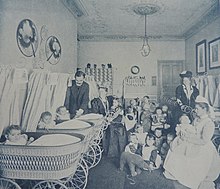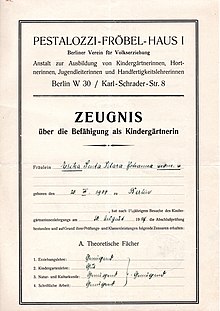Pestalozzi Froebel House
The Pestalozzi-Froebel-Haus (PFH ) is a foundation under public law in Berlin-Schöneberg . It is the sponsor of an educator school, day care centers and other psychosocial and educational institutions for child and youth welfare and a member of the Paritätischer Wohlfahrtsverband .

history
The PFH is one of the oldest training centers in Germany for social professions and has had a decisive influence on the professionalization of female employment in the social service sector. The beginnings of the company were shaped by two women, Henriette Schrader-Breymann and Annette Schepel . On May 16, 1874, the PFH was founded as the “Berlin Association for Public Education” and was initially responsible for a Volkskindergarten . In the founding document, the expansion and improvement of care for young children and the education of young people as well as the training of women for housekeeping and education were named as goals.
Henriette Schrader-Breymann, the chairwoman of the association, soon added a kindergarten teacher seminar to the kindergarten. With reference to the great educators Johann Heinrich Pestalozzi and Friedrich Fröbel , the kindergarten teacher tried to transfer the idea of the educational power of the living room, which Pestalozzi had developed in his writings, to the kindergarten and to bring it into connection with the idea of the "free development of the Child's play ”, which Froebel, Henriette Schrader-Breymann's great-uncle , had highlighted in his works. Schrader-Breymann developed the then innovative “method of the monthly or concentration object” for educational work, which is still used in elementary education today. The starting point of this approximately four-week plan should be the season, the local conditions (city, country) and the age of the children. When planning the work, it was important that all activities, games, songs and stories were grouped around the center, and that the teacher decides which activity is appropriate. The plan was never seen in the sense of a binding school curriculum, but always as an aid for planning work in one's own children's group.
From 1878 handicraft courses had been set up for school children (work school) and a year later an elementary class was added. In 1880 all club facilities were brought together in Steinmetzstraße. Soon other facilities were added, such as a girls' home (1881), a cooking and housekeeping school (1884) by Hedwig Heyl and later a day nursery , placement classes, a pre-class, a youth care center and facilities that are only intended for children whose mothers lack time are prevented from providing adequate care and care for their children. This includes the serving of a warm lunch for a small fee, the opportunity to take a long afternoon rest on suitable beds and regular personal hygiene through baths . In addition, the PFH maintained the Hundert-Eichen children's home in Osterode in the southern Harz region, which served 20 weak children of pre-school age (or first school age) for recreation and physical strength . In connection with the children's home in the Harz Mountains, a reforming home for daughters of educated families was founded, which is supposed to lead the young girls to practical areas of life after leaving a secondary school for girls without giving them actual vocational training. Housekeeping, instruction in horticulture and child care alternate with hours of advanced training .
In 1896 two new stately buildings (House I and House II) were erected on the corner of Kyffhäuserstraße and Barbarossastraße (from 1914 Karl-Schrader- Straße 7/8) in Berlin-Schöneberg . “The establishment would not have flourished without the magnificent new building of the Pestalozzi-Froebel House in Barbarossastrasse. Through the mediation of Ms. Hedwig Heyl, Ms. Schrader, a noble woman in Berlin, Maria Elisabeth Wentzel-Heckmann, was able to interest the ideas and efforts of the large educational institution. Ms. Wentzel-Heckmann bought a large piece of land between Grunewaldstrasse and Barbarossastrasse and donated the capital for the construction of the two well-known houses of Pestalozzi-Fröbel-Haus I and II. The 'Berlin Association for People's Education' was obliged to make certain repayments and interest payments take over. The buildings, begun in 1896, could be occupied in 1898 "
In 1908, Alice Salomon opened the “Social Women's School” (House III) on the grounds of the PFH , supported and funded by the Berlin Association for Public Education in community with the girls and women groups for social aid work . The training center served to prepare young girls and women for voluntary, honorary or professional activity in social or communal areas . In October 1911, Gertrud Holiday started her training here; in the summer of 1914 she became the second director in the children's rest home UOBB Zion-Lodge XV. No. 360 Hanover on Norderney and took over the management of this facility at Easter 1920. In the second half of the 1920s, PFH trainees were often able to gain practical experience in the children's recreation home of the Zion Lodge UOBB .
Alice Salomon founded the German Academy for Social and Educational Women's Work in 1925 , a special advanced training academy for women with a corresponding state examination and three years of professional experience in social work, nursing, housekeeping or teaching at social schools. During the time of the Nazi dictatorship, the PFH, whose chairman Karl Spiewok , main department head of the NSV in the Gau Berlin, was appointed, remained as an independent institution. With the exception of the German Academy for Social and Educational Women's Work, it was not dissolved and also not incorporated into a Nazi organization. Jewish and “non-Aryan” teachers were fired. The teaching and learning content in schools as well as the pedagogy in the social-educational institutions of welfare care had to adapt to the prevailing ideology. For example, Hedwig Koch, Head of House I, wrote in November 1939, immediately after the start of the war:
“Now we're going into winter. The schoolgirls work board games for the soldiers in the hospitals and staple books for them ... We are ready to take on the tasks that the moment will demand of us at any time. We do not yet know what is required of us, because it is like living in the moment between the times. "
Since a considerable part of the buildings of the PFH had been destroyed and damaged by the effects of the war, the reconstruction began after 1945.
Structure and facilities today
The PFH is headed by a directorate and has department heads for the technical school, for child and youth welfare as well as for administration. The employer is the Berlin Senator for Education, Youth and Family Sandra Scheeres. The activities of the institutions are controlled by a board of trustees made up of elected members of the Berlin House of Representatives.
As a free and non-profit organization, the PFH is affiliated with the Paritätischer Wohlfahrtsverband as well as an institution under public law and can therefore employ civil servants.
Currently belong to the facilities of the PFH
- a professional school for social pedagogy with a European profile
- a technical college for health and social affairs
- Day care centers
- All-day areas in schools
- Family centers / neighborhood centers / a multigenerational house
- Open child and youth work (including the Juxirkus Schöneberg )
- Family counseling
- Youth social work in schools
- Work-related educational offers in cooperation with primary and secondary schools
- Therapeutic youth groups / day groups
In 2001 the pedagogical guiding concept Early Excellence was introduced in the PFH , according to which all PFH facilities work today. The Early Excellence initiative started first in the children's and family center in Schillerstraße, then in other daycare centers, elementary school all-day areas, family centers, in the technical college for social education and in all the other facilities belonging to the house. The core ideas of this approach are not new to the PFH, but have been anchored in its tradition from the very beginning. Since the foundation of the PFH, a holistic elementary education, the consideration of the individuality and the family background of each child as well as learning in and through play have been at the center of the pedagogical conception of the all-encompassing educational institution.
The association "Pestalozzi-Froebel Association (PFV)" (Barbarossastraße, not related to the Froebel group ) has a benevolent relationship with the institution.
Former
- Lili Droescher , director and lecturer from 1913 to 1934
- Elise von Hopffgarten , chairwoman until 1922
- Charlotte Dietrich , acting head management in the 1930s
- Martha Abicht , Marie Bloch , Alexandrine Hegemann , Hannah Karminski , Nelly Wolffheim , Käthe Heintze , Elisabeth Blochmann , Anna von Gierke , Hildegard von Gierke , Elisabeth von Grunelius , Isa Gruner , Gertrud Urlaub , Marie Munk , Ella Schwarz
- Hildegard Böhme , teacher in the 1920s
- Margarete Sommer , lecturer at the welfare seminar
- Elfriede Strnad , lecturer
- Erika Hoffmann , 1928–1947 specialist teacher for education and psychology
- Netti Christensen , handicraft teacher around 1946
- Wilhelm Conrad Gomoll , lecturer in literary and art history from 1910–1914
- Ruth Zechlin , lecturer 1932–1938 (1935–38 at the Berlin seminar for social workers)
- Sabine Hebenstreit-Müller , Director of the PFH from 1999–2017
literature
- Working group on the history of the Pestalozzi-Fröbel-Haus (Ed.): The Pestalozzi-Fröbel-Haus. Technical School for Social Pedagogy Berlin. Development of a women's profession. Berlin 1991
- Günter Erning, Karl Neumann, Jürgen Reyer (eds.): History of the kindergarten. Volume II: Institutional Aspects, Systematic Perspectives, Development Processes. Freiburg / Br. 1987, ISBN 3-7841-0379-0 .
- Manfred Berger : Henriette Schrader-Breymann. Life and work of a pioneer in girls' education and kindergarten, Frankfurt / Main 1999
- Adriane Feustel: Social Pedagogy and Gender Relationship 1900 and 2000. Berlin 2003, ISBN 3-930523-13-2 .
- Sabine Hebenstreit-Müller : Learning to observe - the early excellence concept (= contributions to the educational work of the Pestalozzi-Fröbel-Haus. Volume 14). Dohrmann, Berlin 2013, ISBN 978-3-938620-26-7 .
- Erika Sommer (Hrsg.): Festschrift 125 years Pestalozzi-Froebel-Haus. Berlin 1999.
- Josef Voss: History of the Berlin Froebel movement. Weimar 1937.
Web links
- PFH website. In: pfh-berlin.de
- Sabine Sander: Walk through the PFH around 1908 - On the common history of the PFH and the ASFH Lecture on the occasion of the anniversary event of the ASFH. (PDF; 1.5 MB) In: ash-berlin.eu. Alice Salomon University of Applied Sciences Berlin , October 23, 2008
- The early days of the Pestalozzi Froebel House. (No longer available online.) In: pfh-berlin.de. Archived from the original on August 13, 2016 (picture gallery).
- Detailed article about the history of the PFH. In: nifbe.de. Lower Saxony Institute for Early Childhood Education and Development V.
Individual evidence
- ↑ a b c Quoted from the PFH prospectus, archived in the Ida-Seele archive .
- ^ Voss 1937, p. 148.
- ↑ Quotation from the working group “History of the Petalozzi-Froebel House”. 1991, p. 23.
- ↑ Sabine Hebenstreit-Müller: Early Excellence - a strategy for quality development on YouTube , October 1, 2014, accessed on March 31, 2018 (1:23:36 hours).
Coordinates: 52 ° 29 '27.2 " N , 13 ° 21' 5.2" E



